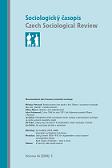Chytanie v žite každodennosti
‘Caught in the Rye’ of Everyday Life
Author(s): Dilbar Alieva (Alijevová)Subject(s): Social Sciences
Published by: AV ČR - Akademie věd České republiky - Sociologický ústav
Keywords: frame analysis; phenomenological sociology; social dramaturgy; sociology of everyday life; Erving Goffman; J. D. Salinger
Summary/Abstract: The idea behind the title of J. D. Salinger’s famous novel The Catcher in the Rye is used in this article to illustrate Erving Goffman’s theoretical approach to everyday life. However unlike Holden Caulfield, who wants ‘to catch’ the children in a ‘big field of rye’ to save them from going over ‘the edge of some crazy cliff’, Goffman does not want to save anybody. In his theory, he only ‘catches in his steely gaze’ (R. Collins) the natural scenes of everyday life. The fluid matter of everydayness is captured by him through theoretical, mainly stylistic tools. Among his favourite rhetorical tools we find metaphor, irony, and so on. Goffman employs stylistic tools to produce what Burke termed ‘perspective by incongruity’. This is a way of perceiving the familiar as problematic. As a social theorist, Goffman preferred formulating a range of concepts over constructing theoretical propositions, and therefore, he was often regarded as the author of a conceptual scheme, not a theory. At best Goffman was perceived as a ‘middle-range’ theoretician. In his own studies of everyday life he used the ethnographic approach of the ‘Chicago school’. The early Goffman was somewhat reserved about applying a phenomenological approach to everyday life. Yet his application of perspective by incongruity served as a substitute for the phenomenological bracketing of the taken-for-granted aspects of everyday life. In his later period, Goffman turned to the procedure of framing, making his approach more structuralist. Frames served to structure the everyday world in many ways. Later, Goffman almost came to accept the Jamesian and Schutzean idea of a multiple reality, with special accent on the frame of everyday conduct, which included both real and unreal elements.
Journal: Sociologický časopis / Czech Sociological Review
- Issue Year: 44/2008
- Issue No: 05
- Page Range: 889-922
- Page Count: 34
- Language: Slovak

